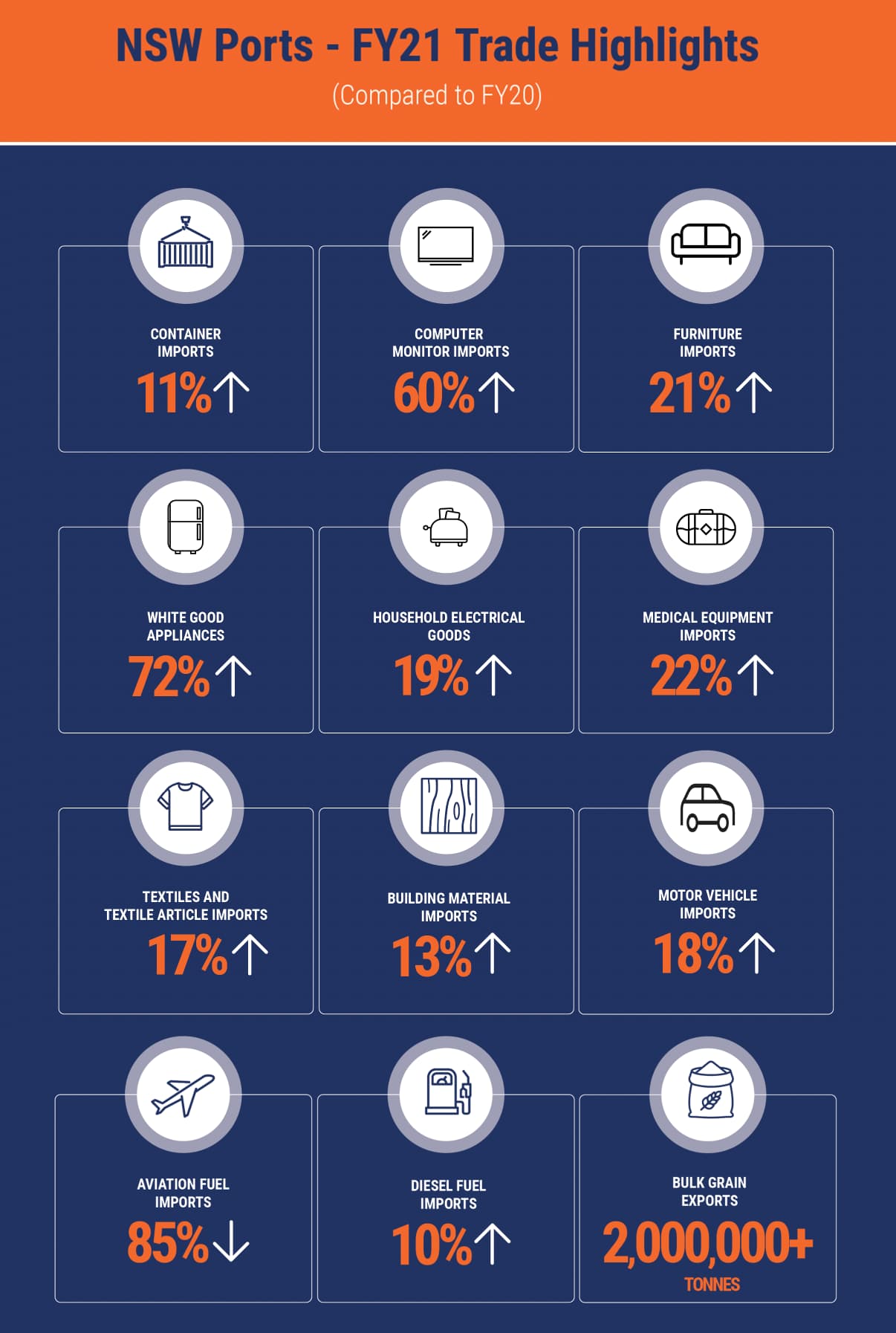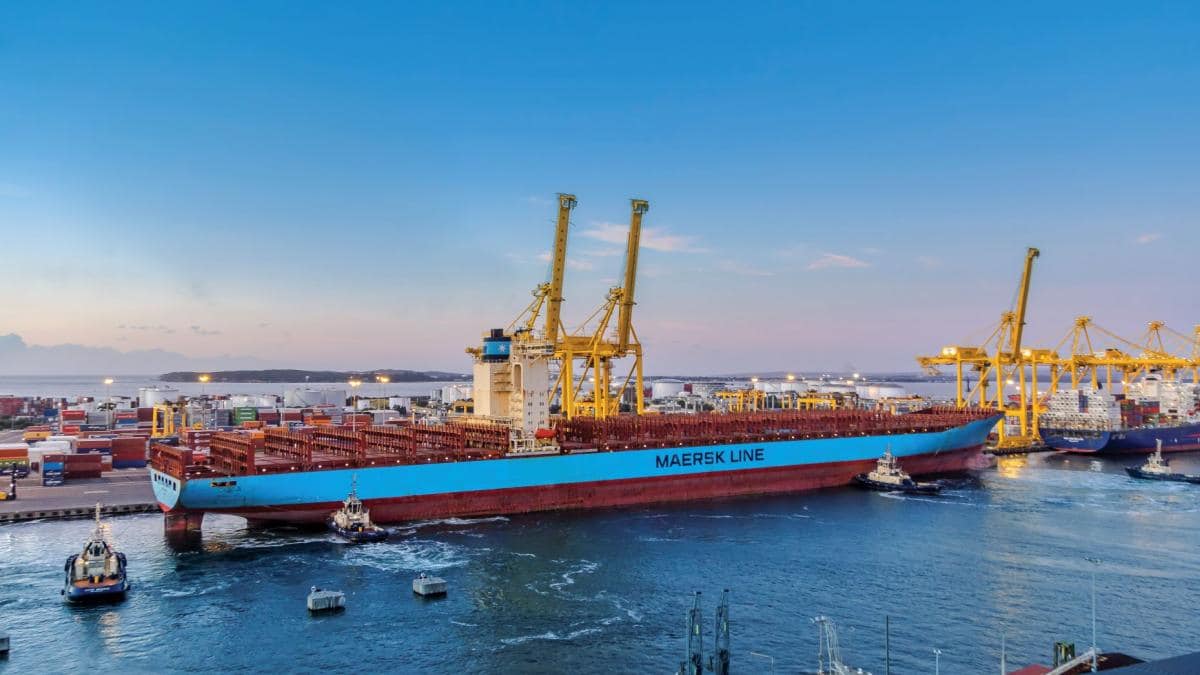NSW Ports CEO Marika Calfas provides an update on trade, operations and key initiatives at Port Botany and Port Kembla.
As we draw to a close on the 2021 financial year, I’d like to share with you an update on key trade trends and activities at our essential trade gateways of Port Botany and Port Kembla.
Whilst global supply chain disruption due to Covid-19 continues, our ports and port supply chains remain resilient but not unaffected. Global disruptions continue to cause flow on delays to vessel arrivals in Australia and capacity limitations. Positively, industrial action at DP World Australia and Hutchison Australia’s Sydney container terminals has ended, however the ongoing industrial action at Patrick Terminals Sydney AutoStrad continues to exacerbate delays and congestion.
In the face of these continued disruptions, it is important that there is collaboration between operators, shipping lines, port managers, shippers and government to ensure we can continue to effectively service the trade needs of the state.
On this note, we encourage shipping lines to continue to work with exporters to address the availability of containers for exports and to provide effective services that meet the needs of exporters to reach their required markets.
It is also critical that we work collectively to ensure industrial lands remain protected from rezoning and urban encroachment. In particular, I would like to draw your attention to a review that the Greater Sydney Commission is undertaking of the “Retain and Manage” policy which protects industrial lands in Greater Sydney from rezoning to other uses, following a recommendation from the NSW Productivity Commission to consider alternative approaches to this existing policy based on maximising net benefits to the State.
The ongoing rezoning of industrial land to uses such as residential and mixed-use development has significantly depleted the available land in eastern and inner west Sydney (and other parts of Greater Sydney) for freight and logistics uses and resulted in constraints to freight and logistics activities in these areas due to amenity issues with encroaching residential development. This ongoing erosion of freight and logistics lands must stop if we are to realise effective and efficient freight and supply chains to service the growing freight needs of the people and businesses of Sydney into the future.
I encourage you to have your views heard on this important issue via the consultation page on the Greater Sydney Commission website and/or contacting us if you would like to support NSW Ports’ actions to highlight the importance of industrial lands for freight and logistics and to prevent urban encroachment. Industry wide support will be more powerful.
Trade
As at the end of financial year 2021, trade trends were:
- Containers – we saw strong growth in container volumes, with the highest volumes on record handled at Port Botany at 2.7M TEU. The primary driver of this growth was container imports, which increased nearly 11% on last year as Australians continued to spend on furniture, electrical items, white goods and home renovation projects instead of travel and experiences. Building material imports also increased 13% on year prior, reflecting Sydney’s busy construction activities.
- Fuel volumes – diesel fuel imports increased 10% on last year, reflecting increased agricultural and freight movements, unleaded fuel recovered from its decline last year with a 13% increase, reflecting the change in public and commuter travel modes, whilst jet fuel imports continued to decline by a further 85% due to the ongoing reduction in flights.
- Cars - motor vehicle imports through Port Kembla increased 18% on prior year, primarily due to government stimulus measures and changes in commuter travel modes. We are also starting to see increasing growth in imports of electric vehicles.
- Agricultural exports remained healthy throughout the year following a resurgence of grain and cotton exports after a prolonged drought in NSW. Bulk grain exports through Port Kembla exceeded 2 million tonnes for the year.
Port Projects & Other Initiatives
Since my last update in March, there has been significant progress on key port projects and initiatives, including:
- On-dock rail: Phase 1 of our joint project with Patrick Terminals to double on-dock rail capacity at its Sydney AutoStrad terminal is now fully operational, and Phase 2 is on track for completion in 2023. Whilst there are disruptions to rail operations at this terminal at the present time, this project will ultimately create supply chain efficiencies and provide improved safety and environmental outcomes. The rail terminal will be able to handle at least 1 million TEU per year once complete. Port Botany is the only port in Australia with on-dock rail at each of the three container terminals and together with our stevedores we are committed to increasing on-dock port rail capacity to three million TEU through a staged investment program at the port.
- Wharf and berth maintenance program - in June we completed a two-year project to rehabilitate Bulk Liquids Berth 1 (BLB1) at Port Botany to protect the structure against the effects of the harsh marine environment for the foreseeable future. A similar project to protect and maintain Brotherson Dock is nearing completion. These investments in sustaining infrastructure will ensure that our key port trade gateways can effectively service NSW’s long-term growing trade needs.
- AIE LNG Import Terminal – work has commenced on Australian Industrial Energy’s LNG Import Terminal at Port Kembla, putting the project on track to be the first LNG import terminal in Australia. This project will bring a new trade to Port Kembla, providing diversification and growth in shipping for the Illawarra region.
- COVID Vaccinations for Seafarers – in May we commenced a program, in partnership with NSW Health, to deliver COVID vaccinations for seafarers onboard vessels that visit the Bulk Liquids Berth in Port Botany on regular rotation. We have now fully vaccinated the crew of three vessels that load and discharge bulk gas at Port Botany and other Australian ports.
- Community Care Grants program – we recently launched our inaugural Community Care Grants Program, offering one-off grants of up to $10,000 to support local projects, services and initiatives that benefit the communities living in close proximity to our operations at Port Botany, Port Kembla, Enfield and Cooks River. We have been thrilled by the community’s response to this program and look forward to sharing more news on our investment in these worthy programs soon.
NSW’s Container Port Strategy
We welcomed the Federal Court of Australia’s dismissal of all claims brought against NSW Ports by the Australian Competition and Consumer Commission (ACCC) and its finding that the Port Commitment Deeds did not have the purpose or likely effect of substantially lessening competition.
The judgment supports the State’s container port strategy, which has identified the most effective use of investment and efficiency of the freight task in NSW is best served by utilising Port Botany’s capacity first, followed by Port Kembla and only then Port of Newcastle. We will continue to focus on ensuring these key trade gateways deliver efficiently and sustainably for the people and businesses of NSW.
We continue to operate in challenging times, with the Covid-19 pandemic ongoing and State based restrictions in place. Working together will continue to be essential if we are to navigate these challenging operational times.
NSW Ports FY21 Trade Highlights


